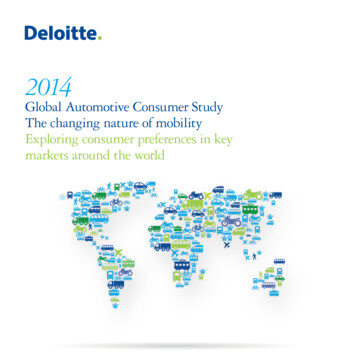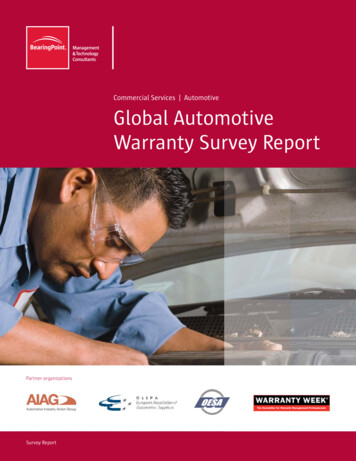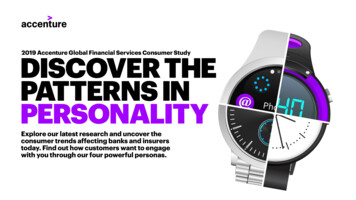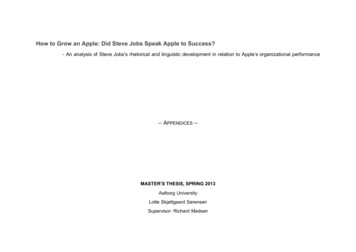
Transcription
2014Global Automotive Consumer StudyThe changing nature of mobilityExploring consumer preferences in keymarkets around the world
22014 Global Automotive Consumer Study
IntroductionForces are changing the mobility landscape, affording consumers more choices than ever before inmeeting their transportation needs. For automotive companies, these shifting consumer demandsresult in a number of complex questions that may ultimately impact their products and how theyengage with their customers.To explore consumers' mobility choices and transportation decisions, Deloitte Touche TohmatsuLimited (DTTL) fielded a survey in 19 countries. In total, more than 23,000 individuals representinga broad range of cross generational Baby Boomers, Generation X (Gen X), and Generation Y(Gen Y) automotive consumers responded to the survey. This broad and diverse consumerdemographic allowed for in-depth analysis through multiple lenses, including generational, socioeconomic, gender, and many others.The objectives of the study centered on understanding the factors influencing consumers' mobilitydecisions as new transportation models (e.g., car-sharing, etc.) emerge. The study also analyzed thedifferent tradeoffs consumers are willing to accept to own a vehicle, and examined how preferencesfor powertrains, technology (inside and outside of the vehicle), and lifestyle needs impact consumers'choice in the purchase or lease decision. The study also sought to assess the customer experience andthe factors influencing the final vehicle purchase decision.The following pages highlight the key findings for six of the 19 countries covered in the study,providing perspectives on the consumer mobility trends in both developed and emerging markets,including the United States, Germany, Japan, China, India, and Brazil. These findings form thefoundation for an informed dialogue between automakers, dealers, and non-automotive companiesworking within the industry about the factors that will increasingly impact how consumers around theworld choose to get from one place to another.
42014 Global Automotive Consumer Study
ContentsAbout the Global Automotive Consumer Study1Global key findings about Gen Y consumers3Why conduct a global automotive study?4Gen Y market potential6Decision criteria7Driver profiles8Vehicle loyalty9Lifestyle10Alternative powertrains12Vehicle technology16Autonomous vehicles18The customer experience192014 Global Automotive Consumer Study5
About the Global Automotive Consumer StudyThe 2014 Global Automotive Consumer Study focuses on "the changing nature of mobility"and how mobility affects various aspects of the automobile buying and ownership experience.Within the mobility theme, the study examines how alternative powertrains, connected vehicletechnology and automation, and the sales channel experience influences the transportationchoices of automotive consumers.Connectedvehicle technologyand automationAlternativepowertrainsKey study themes2014Global AutomotiveConsumer StudyMobility and theevolution oftransportation12014 Global Automotive Consumer StudyConsumer salesand serviceexperience
The 2014 Global Automotive Consumer Studyis based on a survey of over 23,000 consumers in 19countries.Three developed and three emerging markets were selected to further analyze and highlightconsumer trends and insights. Key findings and insights on the following pages are based onresponses from consumers in six focus countries:United StatesGermanyJapanChinaIndiaBrazilParticipating countriesUnited KingdomCanadaNetherlands Germany Czech inaUnited StatesIndiaBrazilArgentinaSouth AfricaFocus countryAustraliaOther survey countries2014 Global Automotive Consumer Study2
Global1 key findings about Gen Y consumersGlobally1, Gen Y consumers areinterested in owning or leasingvehicles, with over 80% inemerging markets expecting tobuy in the next five yearsA majority of Gen Yconsumers think they will bedriving an alternative enginein five years and they arewilling to pay more for it2In all countries1, interest decreases as autonomy increases,but Gen Y consumers in emerging markets are morecomfortable with advanced levels of autonomyConsumers see the greatestbenefits of vehicle technologyin improved safety and increasedfuel efficiencyReasons for not buying: Gen Yfeels that high costs and the factthat lifestyle needs can be met bywalking and public transportationare the primary factorsOver 50% of Gen Y consumers areinfluenced by friends and familyduring the purchase process32014 Global Automotive Consumer StudyGen Y consumers want vehicle technologies that: Recognize the presence of other vehicles on the road Automatically block them from engaging in dangerousdriving situationsSix focus countries (including both emerging and developed markets) were used for globalanalysis: U.S., Germany, Japan, China, India, Brazil.2Although cost is still a primary motivation.1
Why conduct a global automotive study?As these powerful and dynamic forces continue to take shape, consumer mobilitypreferences are rapidly evolving.ImpactDescriptionHyper-urbanization In 2006, the world reached a criticalmidpoint with over half of the world’spopulation was living in a city. The trend isexpected to accelerate, with approximately70% of the world’s population expected tolive in cities by 2050.3 Overcrowding, the realities of traffic, andnew capabilities enabled by technology areleading to more collaborative approachesto transport. For example, the “sharingeconomy,” driverless cars, and improvedpublic transportation. This trend has the potential to threatenvehicle sales, particularly in developedeconomies where profit margins are highertoday.3Generational views Baby Boomers, Gen X, and Gen Yconsumers view their mobility needs andpreferences differently. While Baby Boomers tend to gravitatetoward traditional vehicle ownershipmodels, younger generations are highlyinterested in models that provide access tomobility, allow them to remain connected(and productive), at a reduced cost. These differing expectations of mobility,along with disruptions of traditionalownership models, will change how originalequipment manufacturers (OEMs) engagetheir customers.Connected technology and software Innovations in Vehicle to Vehicle (V2V) andVehicle to Infrastructure (V2I) connectivity,mobile phones, apps, and smart cardtechnology are disrupting the automotiveindustry. Consumers will likely expect experiencesthat go beyond the sales or servicetransaction and leverage technology tointegrate with their connected lifestyles—both inside and outside of the vehicle. The formerly clear lines—between humansand machines, between ownership andnon-ownership, between goods andservices—will blur as a result of connectivityand the information generated and usedinterchangeably by people and machines. This fundamental shift in buying behaviorwith a new generation of consumerspresent significant opportunities andchallenges for OEMs.United Nations Department of Economic and Social Affairs – Population Division, World Urbanization Prospects, The 2011 Revision, March 2012.2014 Global Automotive Consumer Study4
DescriptionDigital exhaust Automobiles and infrastructure willgenerate a large amount of digital exhaustthat will create both opportunities andchallenges for consumers, manufacturers,government, and businesses. Every actiontaken can be measured and quantified inthe connected vehicle ofthe future.Convergence of the public andprivate sectors Government will likely not be able to fullyfund nor take primary responsibility forthe requirements supporting tomorrow'stransportation systems. The sheer complexity of transportationsystems of the future will likely requiremany players to be involved.Impact This data provides opportunities for a moreintegrated and seamless mobility system. If used correctly, this data could allowfor automotive and non-automotivecompanies to gain insight on the consumerbehavior and vehicle performance, aswell as identify new potential growthopportunities and/or business models.5 The mass adoption and use of newpublic transportation, electric cars, andautonomous/driverless cars, and thesupporting infrastructure requirements islikely to require increased public-privatecollaborations to address both developmentcosts and ongoing operations.The International Council on Clean Transportation, Global Comparison of Light-Duty VehicleFuel Economy/GHG Emissions Standards, June 2012.2014 Global Automotive Consumer Study Continued concerns regardingenvironmental sustainability and a focuson improving fuel efficiency are leading toever increasing government targets andexpectations in countries around the worldsuch as EU 2020: 60.6 miles per gallon,Japan 2020: 55.1 miles per gallon, and U.S.2025: 54.5 miles per gallon.4 Automakers are being challenged todevelop more fuel efficient engines andalternative powertrains to comply with theevolving standards. Because data will be produced acrossdisparate sources, management andintegration of the data will be the barrier tooptimizing the use of the data.4Sustainability and environmentalconcerns In the future, consumers will have theability to choose from a mix of provenpowertrain options that best meet theirlifestyle needs and are competitivelypriced – including more efficient internalcombustion engines, electric vehicles (EVs),hybrid electric, and vehicles powered bynatural gas.
Gen Y market potentialOver 80% of Gen Y consumers in emerging marketsplan to purchase or lease a vehicle within the next five years.Percentage of Gen Y consumers who expect to buy a car in the next five yearsIn China and India alone,India92%China90%Brazil83%United States80%Germany76%Japan43%Emerging markets1680 millionGen Y consumers5plan to buy within five yearsDeveloped marketsEstimate using data from the Economist Intelligence Unit (EIU) – Gen Y population (age 20 to 37 years) for India and China iscalculated as: Population in the age group of 20 to 35 years 0.6 X (Population in the age group of 35 to 39 years).2014 Global Automotive Consumer Study6
Decision criteriaAffordability and needs met by walking / public transportationare top reasons across Gen Y for not owning a vehicle.Top three reasons Gen Y does not buy6U.S.GermanyJapan7ChinaIndiaBrazilBut is Gen Y even willing to buy?Percent of population %85%2376%78%CHINAINDIA76%BRAZILTop reason for other generationsAffordabilityParking is inconvenient,unavailable, or too expensiveMaintenance costsLifestyle needs met by bike ormotorized two-wheel vehicleLifestyle needs met bywalking / public transitEnvironmental concernsWhat would get Gen Y into a car?While lower costs and increased fuel efficiencyare primary factors in most countries 72014 Global Automotive Consumer StudyGen Y is more willing and interestedin buying than other generations in allcountries except the U.S.Gen YOther generationsFor segment of Gen Y respondents thatcurrently do not own or lease a vehicle.7Top reason for other generations:Lifestyle needs met by walking / public transit.6 In China and India, parking is also a significant factor – over 50% of Gen Y saymore convenient and less costly parking would get them in a car
Driver profilesMost consumers value low cost,except in China and India, where convenience is most important.Eco-friendlyLow costConvenienceUtilityLuxuryTechnologyLove to driveI make green choicesin my life. Whengoing somewhere, Iwant to do so in aneco-friendly manner,even if that meansmore time andmoney.My total cost whengoing somewhereneeds to be low,and I will choose atransportation optionthat is cheapest.When goingsomewhere, I wantto do so in the fastestand easiest way andam willing to use anytransportation optionto achieve this.I have things todo and gettingsomewhere needsto fit the demandsof my lifestyle.My transportationoption must have thefunctionality to meetthese demands (e.g.,I require a truck tohaul my equipment/tools).I value luxuryand want to benoticed when I gosomewhere. I feel asense of pride drivinga luxury vehicle andam willing to paymore for the featuresand the brand name.Connectedtechnology isimportant tome when goingsomewhere.To do this, mytransportationchoice needs to beintegrated with myelectronic devices,and it needs toaccess, consume, andcreate information.I look forward todriving becausegetting there is halfthe fun.How would you describe yourself as a commuter?Top two most frequent descriptions consumers used to describe themselves as commutersRankingUnited StatesGermanyJapanChinaIndiaBrazil12"Low cost" is not a primary factorin China and India2014 Global Automotive Consumer Study8
Vehicle loyaltyIn all countries except China, Gen Y is not as devoted to the personal car,compared to other generations.The personal car as a preferred mode of transportationU.S.GermanyJapanChinaIndiaBrazil“I would be willing to give up driving my car even ifI had to pay more to travel to where I need to 9%46%42%50%32%52%21%59%19%Gen YOther generationsThe U.S. has the largest gap in vehicle ownershiployalty between Gen Y and other generations, butIndia has the highest abandonment rates.92014 Global Automotive Consumer Study
LifestyleFactors that may influenceconsumers' decision to abandon vehicle ownershipLifestyle is the primary reason.“I would prefer living in a neighborhood that has everything within walking distance.”U.S.GermanyOver half of allconsumers prefer tohave everything withinwalking distanceJapanChinaIndiaBrazilGen Y67% 12%55%53% 4%49%58%While this idea seems tobe more popular withGen Y in developedmarkets 2%56%64%-12%76%68%-5%73%64%.Gen Y in emergingmarkets care less aboutliving in a convenientneighborhood, comparedto other generations-11%75%Other generationsNote: “Strongly Agree” and “Agree” responses have beensummed up together.2014
economy,” driverless cars, and improved public transportation. This trend has the potential to threaten vehicle sales, particularly in developed economies where profit margins are higher today. These differing expectations of mobility, along with disruptions of traditional ownership models, will change how original equipment manufacturers (OEMs) engage their customers. This funda











